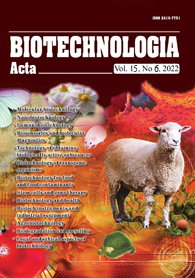ISSN 2410-7751 (Print)
ISSN 2410-776X (Online)
Biotechnologia Acta Т. 14, No. 6 , 2022
P. 70-74, Bibliography 15, Engl.
UDC: 616-006.577.112
https://doi.org/10.15407/biotech15.06.070
Full text: (PDF, in English)
IN VITRO ANTILEUKEMIC ACTIVITY OF EUPHORBIA ECHINUS EXTRACT
1Department of Molecular Biology and Genetics, Faculty of Engineering and Natural Sciences, Üsküdar University, Istanbul, Turkey.
2Department of Bioengineering, Faculty of Engineering and Natural Sciences, Üsküdar University, Istanbul, Turkey.
3Laboratory for improved soil productivity and environment, Higher Normal School, Mohammed V. University, Rabat, Morocco.
Aim. Cancer continues to pose a serious threat to human health. Euphorbia plants are rich in phenolics, aromatic esters, steroids and several bioactive compounds. Studies have shown the presence of a large number of bioactive compounds in E. echinus including flavonoids, phenolics, and proanthocyanins.
Method. There it was investigated cytotoxic effects of E. echinus methanolic extract on K562, HL60, Ishikawa, Raji and SH-SY5Y cells.
Results. The E. echinus extract was found to be highly cytotoxic against HL60 and K562 (79.78 and 76.44% cytotoxicity, respectively). DNA fragmentation was exclusively observed in K562 cells indicating that the reduction of viable cells following treatment with E. echinus extract is due to apoptosis.
Conclusions. Our results suggest that E. echinus extract might have a drug potential against leukemic cells.
Keywords: Euphorbia echinus, cancer, K562 cells, HL60 cells.
© Palladin Institute of Biochemistry of the National Academy of Sciences of Ukraine, 2022
References
1. Gad S.C., Spainhour C.B., Gad S.E. Carcinogenicity and Genotoxicity, in Mammalian Toxicology (ed A.-D. Mohamed B.), John Wiley & Sons, Inc., Hoboken, NJ, USA. Chapter 17, First published: 27 February 2015. https://doi.org/10.1002/9781118683484.ch17
2. Atasever B., Akgun-Dar K., Erdem-Kuruca S., Turan N., Seyhanli V., Meriçli A. Effects of flavonoids obtained from Cynara syriaca on leukemic cells. Ankara Ecz Fak Derg. 2003, 32(3),143̶ ̶ 150. https://doi.org/10.1501/Eczfak_0000000406
3. Arslan B.A., Isik F.B., Gur H., Ozen F., Catal T. Apoptotic effect of Nigella sativa on human lymphoma U937 cells. Pharmacogn Mag. 13(Suppl 3), 2017, 143 ̶ 150. https://doi.org/10.4103/pm.pm_93_17
4. Lahlou F., Hmimid F., Jouti N.T., Bellali F., Loutfi M., Bourhim N. Phytochemical screening, chemical composition and toxicity of Euphorbia echinus. J Biol Chem Res, 2014, 31, 21 ̶ 38. https://doi.org/10.5897/JTEHS12.014
5. Tang Q., Su Z., Han Z., Ma X., Xu D., Liang Y., Cao H., Wang X., Qu X., Hoffman A., Liu H., Gu H., Qiu D. LC-MS method for detecting prostratin in plant extracts and identification of a high-yielding population of Euphorbia fischeriana. Phytochem Lett. 2012, 5(1), 214-218. https://doi.org/10.1016/j.phytol.2011.12.011
6. Demirkiran O., Topçu G., Hussain J., Ahmad V.U., Choudhary M.I., Structure elucidation of two new unusual monoterpene glycosides from Euphorbia decipiens, by 1D and 2D NMR experiments, Magn Reson Chem 2011, v. 49, 673 ̶ 677. https://doi.org/10.1002/mrc.2795
7. Kaya B, Atasever Arslan B, Kalkan Z, Gur H, Ulkuseven B. Apoptotic Mechanisms of N1-acetylacetone, N4-4-Methoxy-Salicylidene-Thiosemicarbazide Chelating with Nickel(II) on HL60 Leukemia Cells. General Physiology and Biophysics. 2016, 35(4), 451 ̶ 458. https://doi.org/10.4149/gpb_2016006a
8. Atasever-Arslan B., Yilancioglu K., Kalkan Z., Timucin A.C., Gür H., Isik F.B., Deniz E., Erman B., Cetiner S. Screening of new antileukemic agents from essential oils of algae extracts and computational modeling of their interactions with intracellular signaling nodes. Eur. J. Pharm. Sci. 2016, v. 83, 120–131. https://doi.org/10.1016/j.ejps.2015.12.001
9. Mohammadi S., Mahboubi A., Mohammadi M., Hedayati M., Jalili A. Assessing the Anticancer Effect of the Euphorbia condylocarpa Plant on AGS Gastric Cancer Cell Line. Gene Cell Tissue. (2017). 4(1):e13298. https://doi.org/10.17795/gct-41223
10. Prakash E., Gupta D.K. Cytotoxic Activities of Extracts of Medicinal Plants of Euphorbiacae Family Studied on Seven Human Cancer Cell lines. Uni J. Plant Sci. 2013, 1(4), 113̶117, https://doi.org/10.13189/ujps.2013.010401
11. Aslanturk O.S., Çelik T.A. Antioxidant, cytotoxic and apoptotic activities of extracts from medicinal plant Euphorbia platyphyllos L. J. Med. Plants Res. 2013, 7(19), 1293- 304. https://doi.org/10.5897/JMPR.12.608
12. Ping K.Y., Darah I., Chen Y., Sasidharan S. Cytotoxicity and genotoxicity assessment of Euphorbia hirta in MCF-7 cell line model using comet assay. Asian Pac. J. Trop. Biomed. 2013, 3(9), 692-696. https://doi.org/10.1016/S2221-1691(13)60140-9
13. Jassbi A.R. Chemistry and biological activity of secondary metabolites in Euphorbia from Iran. Phytochemistr. 2006, v. 67, 1977–1984. https://doi.org/10.1016/j.phytochem.2006.06.030
14. Tugrak BT, Acar DI, Kuşoğlu Gültekin S, Albayrak IG, Akalin E, Atasever-Arslan B. Phytochemical Constituents And Antıleukemıc Effects of Juniperus oxycedrus Extract. Biotechnologia Acta, 2022;15 (5), 64-70. https://doi.org/10.15407/biotech15.05.064
15. Atasever Arslan B, Yilancioglu K, Kuşoğlu Gültekin S, Albayrak IG. Chemical constituent of Isochrysis galbana microalgae extract and its cytotoxic activities on leukemic cell lines. İstanbul Journal of Pharmacy, 2022;52 (1), 64-68. https://doi.org/10.26650/IstanbulJPharm.2022.1057338

